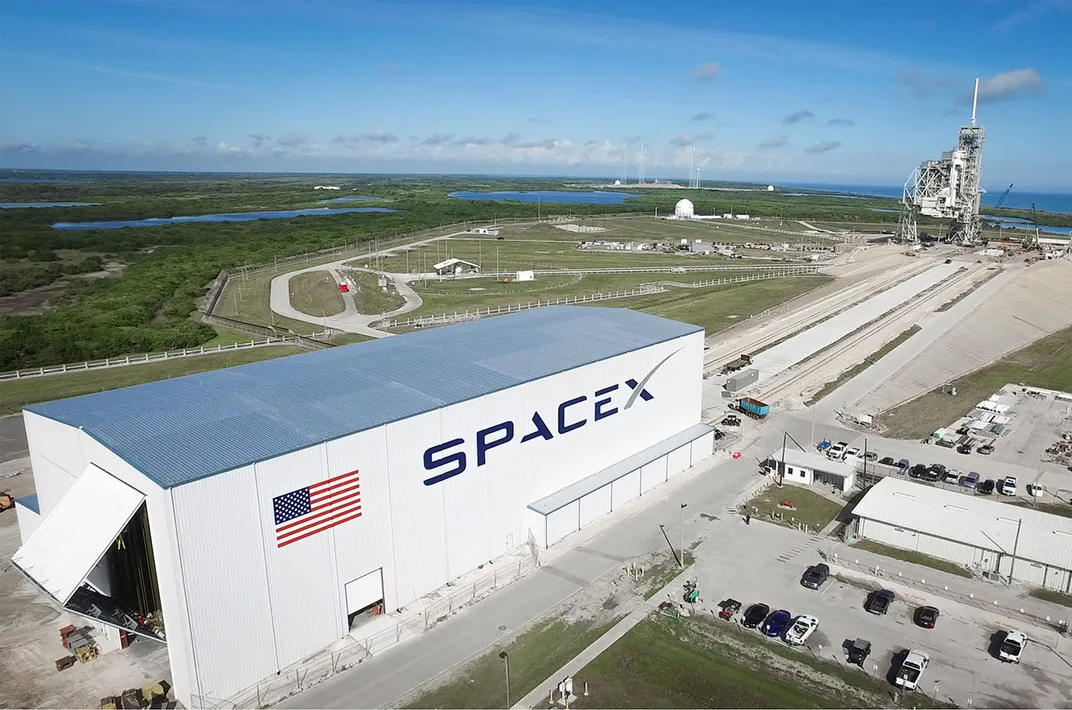SpaceX Launches from Historic Pad 39A
Commercial rockets take center stage at Cape Canaveral.
/https://tf-cmsv2-smithsonianmag-media.s3.amazonaws.com/filer/5e/12/5e12e09a-d360-48cc-8ed1-c35f4743b26d/falcon_9_and_dragon_at_pad_39a.jpg)
A concrete cover now sits atop a flame trench once blasted by the Saturn moon rockets and space shuttles that sent two generations of NASA astronauts into orbit.
It’s one of the more visible reminders that a new chapter is beginning in the life of Kennedy Space Center’s iconic Launch Complex 39A. On Sunday morning, a SpaceX Falcon 9 rocket lifted off from the pad to deliver a cargo ship to the International Space Station for NASA. [Updated February 19]
“This is the same launch pad used by the Saturn V rocket that first took people to the moon in 1969. We are honored to be allowed to use it,” SpaceX founder and chief executive Elon Musk wrote on Twitter.
When NASA’s rockets flew from 39A—the last time was the final space shuttle mission in 2011—they sat on a mobile launcher platform that straddled the open flame trench. There is still a hole under the Falcon rocket, but the fire will be contained by the concrete cover and piped away.
SpaceX doesn’t need the old launch platform or the giant “crawler” transporter that carried NASA vehicles to the pad from their assembly building. Instead, the company built a processing hangar at the base of the pad’s southern perimeter. Falcons will lie on their side during the ride to the launch pad atop a newly built transporter. Then they’ll be raised to vertical position at the pad.

Some shuttle-era equipment remains, including the Fixed Service Structure, the pad’s most prominent feature. The tower stands 347 feet from ground level to the tip of its lightning mast. SpaceX plans to extend the structure and build a new access arm for astronauts to use as a walkway into the company’s Crew Dragon capsules.
The access arm and “white room” used by shuttle crews that flew from 39A—one of two shuttle-era pads—were saved as historical artifacts, and are currently displayed outside the gigantic Vehicle Assembly Building where the shuttle parts were assembled.
For now, the shuttle’s 130-foot-tall Rotating Service Structure, which were used to enclose and protect the orbiters as they sat on the pad, remains on the west side of 39A’s flame trench. SpaceX has begun dismantling the structure.
“The priority is getting launching right now, and the tower is not really in the way … but eventually it will come down,” said Stephen Payne, a former shuttle test director who now serves as NASA’s launch integration manager for the Commercial Crew program.
SpaceX refurbished the pad’s sound-suppressing water deluge system, replaced electronics, power and plumbing lines, and upgraded the liquid oxygen “farm.” SpaceX uses highly densified liquid oxygen to give its boosters added power to return to the launch site instead of being ditched in the ocean. The company aims to launch its first recycled rocket in a few months.
For fuel, the Falcons use RP-1, a highly refined form of kerosene. The shuttles used liquid hydrogen, but the Saturn moon rockets also used RP-1.
“There was an old abandoned pad where the Apollo RP-1 facility used to be. SpaceX cleaned it off and built a whole new RP-1 facility on top of that …. It’s really nice,” Payne said.
SpaceX has not said how much it spent to refurbish the pad, but it’s taken nearly three years to get it ready for flight. The company signed a 20-year lease for 39A in April 2014.
“There’s nothing in particular that gave us a hard time. The whole thing is just a huge effort,” said Hans Koenigsmann, SpaceX vice president of mission assurance.
For example, the complex’s new transporter-erector, which supports the rockets and hoists them upright for launch, was built to accommodate the heavy-lift version of Falcon, which is scheduled for a debut flight from 39A this year.
“The transporter-erector is like 1.5 million pounds of steel ... just huge,” Koenigsmann said.
Getting 39A operational took on a note of urgency after a Falcon 9 rocket explosion last September heavily damaged SpaceX’s original launch pad, located at Cape Canaveral Air Force Station, just south of Kennedy Space Center.
SpaceX is repairing that pad and expects to return it to service before the end of the year. The company also flies polar and high-inclination orbit missions from Vandenberg Air Force Base in California and is building a fourth launch site in Texas.